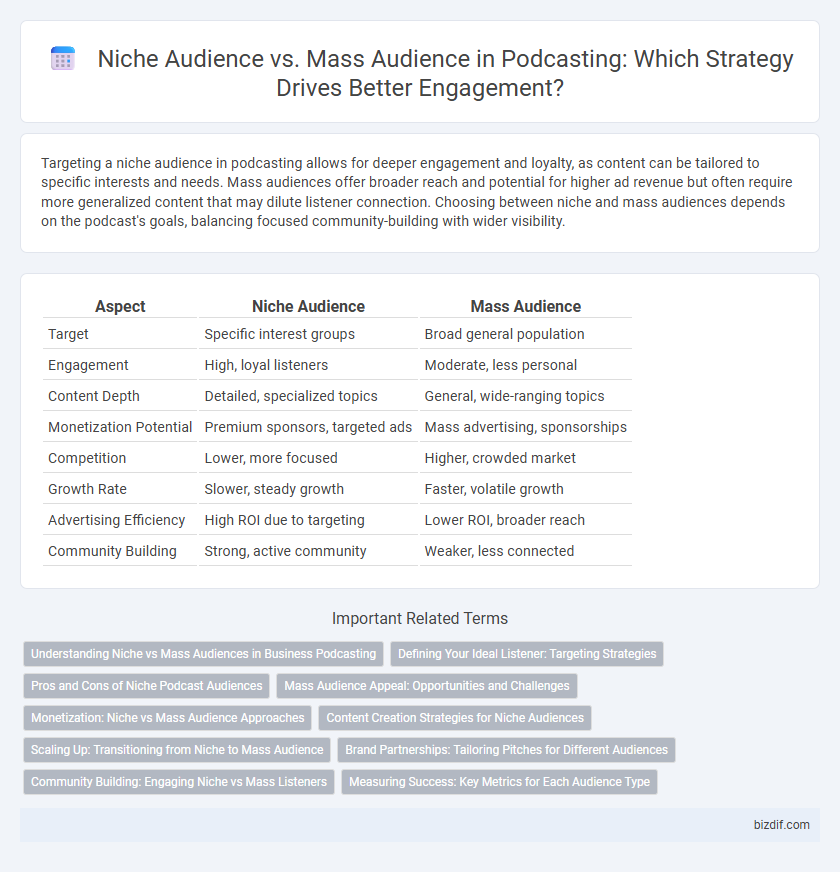Targeting a niche audience in podcasting allows for deeper engagement and loyalty, as content can be tailored to specific interests and needs. Mass audiences offer broader reach and potential for higher ad revenue but often require more generalized content that may dilute listener connection. Choosing between niche and mass audiences depends on the podcast's goals, balancing focused community-building with wider visibility.
Table of Comparison
| Aspect | Niche Audience | Mass Audience |
|---|---|---|
| Target | Specific interest groups | Broad general population |
| Engagement | High, loyal listeners | Moderate, less personal |
| Content Depth | Detailed, specialized topics | General, wide-ranging topics |
| Monetization Potential | Premium sponsors, targeted ads | Mass advertising, sponsorships |
| Competition | Lower, more focused | Higher, crowded market |
| Growth Rate | Slower, steady growth | Faster, volatile growth |
| Advertising Efficiency | High ROI due to targeting | Lower ROI, broader reach |
| Community Building | Strong, active community | Weaker, less connected |
Understanding Niche vs Mass Audiences in Business Podcasting
Focusing on a niche audience in business podcasting enables deeper engagement through tailored content that addresses specific industry challenges, fostering loyalty and higher conversion rates. Mass audiences offer broader reach but often result in diluted messaging and lower interaction due to diverse listener interests. Understanding these dynamics helps podcasters optimize content strategy, balancing specialized insights with scalability to maximize impact and ROI.
Defining Your Ideal Listener: Targeting Strategies
Defining your ideal listener requires identifying specific demographics, interests, and pain points within a niche audience to create highly relevant and engaging podcast content. Targeting a niche audience builds loyalty and fosters community, often resulting in higher engagement rates and stronger word-of-mouth growth compared to broader mass audiences. Utilizing data-driven insights and listener personas enhances targeting strategies, ensuring content resonates deeply and drives sustained audience retention.
Pros and Cons of Niche Podcast Audiences
Niche podcast audiences offer higher engagement due to specialized content tailored to specific interests, leading to stronger community loyalty and more targeted advertising opportunities. However, niching limits overall reach and potential listener growth compared to mass audience podcasts, which benefit from broader appeal and larger subscriber bases. Creators targeting niche audiences often face challenges in monetization and slower audience accumulation but gain the advantage of deeper audience connection and reduced competition.
Mass Audience Appeal: Opportunities and Challenges
Mass audience appeal in podcasting offers opportunities for broader reach and increased advertising revenue, as shows targeting diverse demographics attract more sponsors. High listener volume enables scalable content monetization but demands content that balances general interest with engagement to avoid listener drop-off. Challenges include fierce competition and the difficulty of maintaining distinctive branding while appealing to varied tastes across large audiences.
Monetization: Niche vs Mass Audience Approaches
Monetizing a podcast with a niche audience often yields higher engagement rates and targeted advertising opportunities, as sponsors seek to connect with specific demographic segments, leading to better conversion rates and premium ad pricing. In contrast, a mass audience approach provides scale, attracting a broader range of advertisers but often results in lower CPM (cost per thousand impressions) due to diluted targeting precision. Successful podcast monetization strategies balance audience specificity and size, leveraging niche appeal for value-driven partnerships or mass reach for volume-based revenue streams.
Content Creation Strategies for Niche Audiences
Content creation for niche audiences involves crafting highly specific, relevant topics that deeply resonate with a targeted group, fostering strong community engagement and listener loyalty. Tailoring podcasts with expert insights, specialized language, and focused themes maximizes retention and attracts advertisers seeking precise demographics. This strategic focus contrasts with mass audience approaches by prioritizing quality interactions over quantity, resulting in authentic connections and sustainable growth within a defined market segment.
Scaling Up: Transitioning from Niche to Mass Audience
Scaling up a podcast involves shifting focus from a tightly defined niche audience to a broader mass audience, requiring content adaptation to maintain relevance while attracting diverse listeners. Effective strategies include diversifying topics, enhancing production quality, and leveraging cross-platform promotion to increase reach and engagement. Understanding listener data analytics and feedback is critical for refining content to appeal to wider demographics without alienating core fans.
Brand Partnerships: Tailoring Pitches for Different Audiences
Brand partnerships in podcasting thrive when pitches are tailored to the audience size and specificity; niche audiences offer highly engaged, targeted listeners valuable for specialized products, while mass audiences provide broader reach for mainstream brands. Understanding listener demographics and interests enhances pitch effectiveness, ensuring brand messages resonate authentically with either a focused or wide-ranging audience. Customizing content proposals based on audience analytics drives higher conversion rates and sustained brand affinity.
Community Building: Engaging Niche vs Mass Listeners
Engaging a niche audience in podcasting fosters a stronger sense of community through targeted content and meaningful interactions, leading to higher listener loyalty and participation. Mass audiences offer broader reach but often result in diluted engagement due to diverse interests and less personalized communication. Prioritizing niche community building enhances listener retention and creates opportunities for tailored sponsorships and collaborations.
Measuring Success: Key Metrics for Each Audience Type
Measuring success in podcasting depends on the audience type, where niche audiences prioritize engagement metrics such as listener retention rate, average listening time, and social media interaction to assess loyalty and content relevance. In contrast, mass audiences emphasize reach metrics like total downloads, unique listeners, and overall market penetration to gauge broad appeal and brand awareness. Understanding these key performance indicators helps podcasters tailor content strategies and advertising models effectively for each audience segment.
Niche Audience vs Mass Audience Infographic

 bizdif.com
bizdif.com